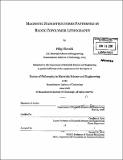Magnetic nanostructures patterned by block copolymer lithography
Author(s)
Ilievski, Filip, 1980-
DownloadFull printable version (49.61Mb)
Other Contributors
Massachusetts Institute of Technology. Dept. of Materials Science and Engineering.
Advisor
Caroline A. Ross.
Terms of use
Metadata
Show full item recordAbstract
The aim of this research was twofold: understanding the methods of patterning magnetic films using self-assembled block copolymer masks and examining the magnetic reversal mechanisms of as deposited and patterned magnetic films. Ti / Co 66 at. % Cr 22 at. % Pt 12 at. % (CoCrPt) films with perpendicular magnetic anisotropy were deposited on silicon wafers by UHV sputtering. Ti was used as an adhesion layer and texture promoter so that the easy magnetic axis of Co is aligned perpendicular to the sample plane. Magnetic reversal of Ti/CoCrPt films and Ti/CoCrPt/Ti/CoCrPt pseudo spin valve films is a domain nucleation and growth process with a slow time-dependent magnetization reversal which was attributed to growth of reverse domains. The films were patterned into nanosized islands by block copolymer lithography using self assembled polystyrene-polyferrocenyldimethylsilane (PS-PFS) as a mask. The islands reverse their magnetization in a coherent and independent fashion (StonerWohlfarth reversal), in contrast to the continuous film. Micromagnetic simulation confirmed the coherent reversal of the thicker islands. Two graphoepitaxy methods were examined for inducing long range order (LRO) in block copolymers. Nanoimprint lithography with in-situ annealing was successful in guiding the self assembly of the block copolymers in the grooves, however, no LRO was achieved. Selectively removable polymeric templates fabricated out of BARL-i@ anti reflection coating guide the self-assembly of PFS domains with good LRO and very few defects over a large area. The ordered arrays were then transferred into silica and W, forming an ordered array of cp-packed W islands with period of 29 nm and island diameter of 17 nm. Transfer of the pattern into CoCrPt is difficult due to the nonselective ion beam etching process.
Description
Thesis (Ph. D.)--Massachusetts Institute of Technology, Dept. of Materials Science and Engineering, 2008. "June 2008." Includes bibliographical references.
Date issued
2008Department
Massachusetts Institute of Technology. Department of Materials Science and EngineeringPublisher
Massachusetts Institute of Technology
Keywords
Materials Science and Engineering.